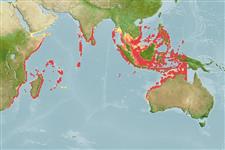Environment: milieu / climate zone / depth range / distribution range
экология
морской ассоциированный с рифами; пределы глубины 1 - 70 m (Ref. 4319). Tropical; 17°N - 33°S, 29°E - 137°E (Ref. 5222)
Indo-West Pacific: Kenya to South Africa (32°S) and east to the Watubela Group of the eastern Banda Sea. Not known from the Red Sea nor Persian Gulf.
Length at first maturity / Size / Вес / Возраст
Maturity: Lm 23.0 range ? - ? cm
Max length : 55.0 cm TL самец/пол неопределен; (Ref. 4319); наибольший вес (опубликованные данные): 2.7 kg (Ref. 4787)
колючие лучи спинного плавника (общее число): 11; членистые (мягкие) лучи спинного плавника (общее число): 16-17; колючие лучи анального плавника 3; членистые (мягкие) лучи анального плавника: 8. Similar to E. maculatus but fewer spots and posterior ones elongated (Ref. 48635); Characterized by greyish brown color with pale blotches; head with widely scattered brown spots; diagonally elongated spots on body becoming more numerous posteriorly; dorsal fin with large dark blotches; ctenoid scales on body except cycloid on nape, thorax and lower abdomen; body with auxiliary scales; greatest depth of body 2.8-3.3 in SL; slightly rounded caudal fin; pelvic fins 1.8-2.3 in head length (Ref. 90102); head length 2.4-2.6 times in SL; flat to slightly convex interorbital area, convex dorsal head profile; preopercle angle with enlarged serrae and a shallow in indentation just above the angle; straight or slightly convex upper edge of operculum; posterior nostril not much larger than anterior nostril; maxilla reaches to or past vertical at rear edge of eye, ventral edge with blunt hook like process distally in fish larger than 35 cm SL; 2 rows of teeth on midlateral part of lower jaw (Ref. 89707).
Inhabit coral reefs or rocky areas and occasionally on sandy bottom. Feed mainly on crustaceans, especially crabs and stomatopods, rarely on small fishes, squids, and pelecypod flesh. Used in Chinese medicine (Ref. 12166). Solitary (Ref 90102).
Heemstra, P.C. and J.E. Randall, 1993. FAO Species Catalogue. Vol. 16. Groupers of the world (family Serranidae, subfamily Epinephelinae). An annotated and illustrated catalogue of the grouper, rockcod, hind, coral grouper and lyretail species known to date. Rome: FAO. FAO Fish. Synop. 125(16):382 p. (Ref. 5222)
Статус Красного Списка МСОП (Ref. 130435)
Угроза для людей
Harmless
Использование человеком
рыболовство: коммерческий
дополнительная информация
ссылкиаквакультура (рыбоводство)особенности рыбоводствастепень растяжениягенетикаElectrophoresesнаследуемостьболезниобработкаNutrientsMass conversion
инструменты
Специальные отчеты
Скачать в формате XML
ресурсы в Интернет
Estimates based on models
Preferred temperature (Ref.
123201): 25.6 - 29, mean 28.2 °C (based on 716 cells).
Phylogenetic diversity index (Ref.
82804): PD
50 = 0.5000 [Uniqueness, from 0.5 = low to 2.0 = high].
Bayesian length-weight: a=0.01950 (0.01119 - 0.03397), b=3.13 (2.98 - 3.28), in cm total length, based on LWR estimates for this species & Genus-body shape (Ref.
93245).
Trophic level (Ref.
69278): 4.2 ±0.62 se; based on food items.
устойчивость к внешним воздействиям (Ref.
120179): средний (среднего размера), минимальное время удвоения популяции 1.4-4.4 года (Preliminary K or Fecundity.).
Fishing Vulnerability (Ref.
59153): Moderate vulnerability (42 of 100).
Nutrients (Ref.
124155): Calcium = 25.6 [12.7, 52.7] mg/100g; Iron = 0.458 [0.250, 0.937] mg/100g; Protein = 18.6 [17.1, 20.0] %; Omega3 = 0.127 [0.081, 0.202] g/100g; Selenium = 35 [21, 62] μg/100g; VitaminA = 194 [55, 690] μg/100g; Zinc = 1.19 [0.82, 1.66] mg/100g (wet weight); based on
nutrient studies.
